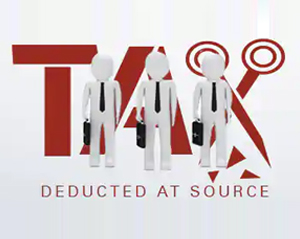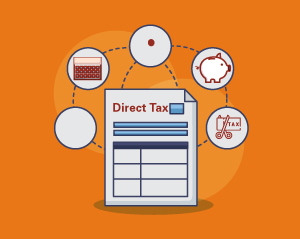Income tax is a financial and legal obligation in India. All individuals earning above a certain amount are required to pay income tax on their earned income. The income tax rates, income slabs, and rules are regulated by the government and are subject to change from time to time. However, all taxpayers are responsible for accurately reporting their income and filing their taxes on time. Failure to do so can result in penalties and fines.
Definition of Income Tax
Income tax is a tax charged on the annual income of an individual or business earned in a financial year. The Income Tax system in India is governed by the Income Tax Act, 1961, which lays out the rules and regulations for income tax calculation, assessment, and collection. All taxpayers are mandated to submit an Income Tax Return (ITR) every year by respective due dates as per the law to report their income and claim a tax refund if applicable. An income tax return can be filed online or offline on the Income Tax Department's official website or through verified third-party websites.
The Indian Income Tax system also includes various deductions and exemptions that can be used to lower the tax liability for a given financial year.
Who Is Required to Pay Income Tax?
Any individual earning more than ₹ 2.5 lakh annually in a financial year is required to pay income tax to the Government of India. Here are the different types of taxpayers in India:
- Individuals: (Further divided as individuals under 60 years, individuals between the ages of 60 and 80 years, and individuals aged over 80 years)
- Hindu Undivided Family (HUF)
- Association of Persons (AOP)
- Artificial Juridical Person
- Firms
- Companies
For the purpose of Income-tax Law, an individual may have any one of the following residential statuses:
- Resident and ordinarily resident in India (ROR)
- Resident but not ordinarily resident in India (RNOR)
- Non-resident (NR)
Under Indian tax laws, the scope of taxation differs as per the residential status of an individual:
- RORs are subject to tax in India on their global income, wherever received
- RNORs are subject to tax in India only in respect to income that accrues/arises or is deemed to accrue/arise in India, or is received or deemed to be received in India, or is from a business controlled from India or from a profession set up in India
- NRs are subject to tax in India only in respect to income that accrues/arises or is deemed to accrue/arise or is received or deemed to be received in India
| Nature of income | Residential status | ||
|---|---|---|---|
| ROR | RNOR | NR | |
| Income which accrues or arises in India | Taxed | Taxed | Taxed |
| Income which is deemed to accrue or arise in India | Taxed | Taxed | Taxed |
| Income which is received in India | Taxed | Taxed | Taxed |
| Income which is deemed to be received in India | Taxed | Taxed | Taxed |
| Income accruing outside India from a business controlled from India or from a profession set up in India | Taxed | Taxed | Not taxed |
| Income other than above (i.e., income which has no relation with India) | Taxed | Not taxed | Not taxed |
Income Tax Act
The Income Tax Act, 1961 is the primary law governing the collection, computation, and administration of income tax in India. The act lays down all the rules and regulations as well as the rights and responsibilities of taxpayers. It also underlines the Income Tax Department's role in the collection of tax and tax returns.
The Income Tax Act, 1961 includes various sections and sub-sections, like Section 80C, Section 80D, Section 80G, Section 10(10D), and several others highlighting the exemptions, deductions, as well as limits to help taxpayers reduce their taxable income and compute their tax liabilities accurately.
Income Tax Return (ITR)
The ITR is a document that all taxpayers are required to file with the Income Tax Department of India. It consists of details on the income earned during a financial year and the taxes owed to the government. It is mandatory to submit the tax return each year under Section 139 of the Income Tax Act, 1961. Failure to file the return on time can result in a late fees under Section 234F of the Income Tax Act, 1961.
There are two ways to file a tax return in India - offline or online.
e-Filing Income Tax
The government allows taxpayers to file their returns online from the comfort of their homes and offices. Electronically filing (e-filing) tax returns offer several advantages. It takes less time. The computation of tax becomes simpler as the process is straightforward and streamlined. Taxpayers also do not necessarily need to hire tax professionals or chartered accountants to file their returns but can do so themselves. This helps save money too. Moreover, e-filing is a 24x7 service, and taxpayers can easily track the status of their claims/refunds online.
Income Tax Calculation
Income tax calculation can be done manually by taxpayers. Alternatively, they can also use an online income tax calculator. The calculation of income tax is done on the basis of the tax slab, the individual falls into. Additionally, taxpayers can also claim tax deductions and exemptions, such as on life insurance premiums, investments in the Public Provident Fund (PPF), National Pension Scheme (NPS), House Rent Allowance (HRA), Leave Travel Allowance (LTA), and more. The government also offers a standard deduction of up to ₹ 50,000.
About Income Tax Department, India
The Income Tax Department is a Ministry of Finance, Government of India organisation. It administers the collection, computation, and refund of direct taxes, such as income tax, in the country. The department works under the Central Board for Direct Taxes (CBDT).
Income Tax Payment Details
Taxpayers may require their Permanent Account Number (PAN) to pay their income tax on the income tax portal.
Additionally, taxpayers can pay their income tax using net banking with an authorised bank.
Income Tax Forms List
There are different ITR forms to pay income tax in India that taxpayers can choose from, based on the type of income and nature of employment.
ITR 1
For individuals being a resident (other than not ordinarily resident) having total income up to ₹ 50 lakh, having Income from Salaries, one house property, other sources (Interest etc.), and agricultural income up to ₹ 5,000/-
ITR 2
For individuals and HUFs having a total income of more than ₹ 50 lakh. Also, Individuals and HUFs not having income from profits and gains of business or profession can opt for this form. Individuals and Non-Resident Indians (NRIs) not having income from profits and gains of business or profession can also use this form.
ITR 3
For individuals and HUFs having a total income of more than ₹ 50 lakh. Also, Individuals and HUFs not having income from profits and gains of business or profession can opt for this form. Individuals and Non-Resident Indians (NRIs) not having income from profits and gains of business or profession can also use this form.
ITR 4
For Individuals, HUFs and Firms (other than LLP) being a resident having total income up to ₹ 50 lakh and having income from business and profession which is computed under sections 44AD, 44ADA or 44AE and agricultural income up to ₹ 5,000/-
ITR 5
For persons other than individual, HUF, company and person filing Form ITR-7
ITR 6
For companies that have not claimed a tax exemption under Section 11 need to use ITR 6.
ITR 7
For Persons including companies who need to file their tax returns under Section 139(4A), Section 139(4B), Section 139(4C), Section 139(4D), Section 139(4E), and Section 139(4F) must use ITR 7.
ITR V
ITR V is the acknowledgement form that is used for the verification of a tax return. This should be duly e-verified In case e-verification is not possible, it is to be signed and sent to the Income Tax Department, Centralised Processing Centre (CPC) in Bangalore.
Investment Options for Income Tax Saving in 2023
Fixed Deposit
Tax-saving fixed deposits are a low-risk savings tool with a guaranteed# return. Fixed deposits are time deposits that have a lock-in period of five years. The rate of interest can also differ from bank to bank. Five-year fixed deposits are the only type of savings deposit that is covered under Section 80C for tax* deductions.
# T&C Apply
Public Provident Fund
The Public Provident Fund is a government-backed savings scheme. It has a maturity period of 15 years. However, account owners are allowed to make withdrawals every year from the seventh financial year onward. It is suitable for long-term goals because of the lock-in periods. Moreover, it offers low risk and can be ideal for conservative investors. It also offers tax* deductions under Section 80C.
Unit Linked Insurance Plan (ULIP)
A Unit Linked Insurance Plan is a type of insurance product. However, apart from life insurance, it also allows investors to invest their money in the funds of their choice. This unique product secures the life insured financially while enabling them to fulfil various financial goals by investing in equity, debt, and hybrid funds. ULIPs have a five-year lock-in period, and their returns can vary based on the choice of funds and prevailing market conditions. However, they can be the most suitable for long-term goals like your child's higher education, your retirement, and more. ULIPs offer tax* deductions under Section 80C and proceeds are exempt subject to conditions under Section 10(10D).
National Savings Certificate
The National Savings Certificate is another one of the Government of India-backed savings schemes. However, it can only be opened in a post office. It is primarily aimed at encouraging small to mid-income investors to save for their future needs. It is a low-risk plan with a guaranteed# return and tax* deductions under Section 80C.
# T&C Apply
Senior Citizen Savings Scheme
The Senior Citizen Savings Scheme is a special savings scheme for senior citizens. Only people over the age of 60 can use it to save for their retirement needs. Since it is aimed at senior citizens, it contains low risk. It also offers deductions subject to conditions prescribed under Section 80C*.
Life Insurance
Life insurance is a financial tool that offers financial protection against loss of life during the policy tenure. Life insurance offers guaranteed# payouts to the insured's beneficiary in the case of an unfortunate event. There are several types of life insurance plans, such as term insurance, endowment insurance, annuity insurance, ULIPs, and more. All of these offer tax* benefits subject to conditions prescribed under Section 80C* and Section 10(10D)*.
# T&C Apply
Pension Plans
Pension plans are a type of life insurance tool that offers dual benefits. These plans offer financial protection against loss of life during the policy term while allowing investors to build a retirement nest egg for their future needs. Pension plans also offer a guaranteed# return and can be used to create an assured stream of income after retirement. Additionally, they offer deductions subject to conditions prescribed under Section 80C* & 80CCC.
# T&C Apply
Health Insurance or Mediclaim
Health insurance is a type of insurance that offers financial protection against the treatment of illnesses and injuries. It can also be used to cover supplementary costs like ambulance expenses, pre- and post-hospitalisation care, preventative health check-ups, medicines, room rent at the hospital, and more. The premiums paid towards a life insurance plan qualify for deductions subject to conditions prescribed under Section 80D*. These deductions can be made for a policy for self, spouse, dependent children, and parents.
New Pension Scheme
The New Pension Scheme is a voluntary defined pension plan. The scheme has two accounts- Tier 1 and Tier 2. Tier 1 is mandatory for all government servants who joined the service on or after January 1, 2004. Tier 2 is an optional account. The scheme qualifies for deductions subject to conditions prescribed under Section 80C* and Section 80CCD*.
Tax-Saving Mutual Funds
Some mutual funds, like the Equity-Linked Savings Scheme (ELSS), also qualify for deductions subject to conditions prescribed under Section 80C*. ELSS funds invest in equity and equity-related securities and have lock-in period of three years. They can be ideal for high-risk investors with a long investment horizon as they are subject to market volatility. There is no guarantee of a return. However, they have delivered high gains over the long term.
Income Tax Deduction Section List
Section 80C
Section 80C* of the Income Tax Act, 1961 allows for tax deductions on several types of investments and expenses, such as contributions to fixed deposits, PPF, NPS, life insurance premiums, and more. The section allows a deduction of up to a maximum limit of ₹ 1.5 lakh per annum.
Section 80CCC
Section 80CCC offers tax deductions of up to ₹ 1.5 lakh per annum for contributions towards pension funds offered by a life insurance company. Taxpayers can claim the money spent on the purchase, renewal, and continuation of such pension plans.
Section 80CCD
Section 80CCD offers tax deductions on contributions made to the National Pension Scheme (NPS) and Atal Pension Yojana (APY). Taxpayers can claim a tax deduction of up to ₹ 1.5 lakh in a financial year under Section 80CCD(1) and an additional deduction of ₹ 50,000 under Section 80CCD(1B) per annum.
The aggregate amount of deductions under Section 80C, Section 80CCC & Section 80CCD(1) shall not be more than ₹ 1.5 lakh per annum.
Section 80D
Section 80D* pertains to tax deductions for medical insurance premiums. It offers a deduction of up to a maximum limit of ₹ 25,000 in a financial year for a policy bought for self, spouse, and dependent children. It further offers a tax deduction of up to ₹ 50,000 per annum if any of the insured is a senior citizen. Hence, the maximum tax deduction under this section can be extended to ₹ 1 lakh in a financial year.
Section 80DDB
This section offers a tax deduction on the expenses incurred on the treatment of specified diseases and ailments. It includes neurological diseases where the disability level is 40% and above, malignant cancers, chronic renal failure, haematological disorders, and others. The section offers a tax deduction of ₹ 40,000 per annum, or the amount actually spent, whichever is less. For senior citizens, the amount is increased to ₹ 1,00,000 per annum, or the amount actually spent, whichever is less.
Section 80E
This section offers tax deductions on interest paid for education loans. The deductions are available for a maximum period of 8 years or till the interest is paid, whichever is earlier. There is no limit on the amount of tax deduction.
Section 80EE
Section 80EE* of the Income Tax Act, 1961 offers a tax deduction on the interest paid for a loan for a residential property. The maximum tax deduction can be up to ₹ 50,000 in a financial year.
Section 80RRB
Residents in India earning income from royalty from a patent registered on or after April 1, 2003, under the Patents Act, 1970, can claim a tax deduction of up to ₹ 3 lakh per annum or the whole income earned from royalty, whichever is less.
Section 80TTA
Section 80TTA* of the Income Tax Act, 1961 offers a tax deduction of up to ₹ 10,000 per annum on the income earned from interest on savings account deposits of a bank, post office, or co-operative society.
Section 80U
Section 80U* offers tax deductions to disabled persons with at least 40% disability, as declared by a certified medical authority. The maximum tax deduction limit is ₹ 75,000 or ₹ 1,25,000 in a financial year if the disability is certified as 80%.
Section 24
This section allows house owners to claim a tax deduction of up to ₹ 2 lakh in a financial year on the interest paid for a home loan.
Income Tax Benefits on Life Insurance
Life insurance plans qualify for tax benefits subject to conditions prescribed under Section 80C* of the Income Tax Act, 1961. The premiums paid towards the life insurance plan can be claimed as deductions with a maximum of up to ₹ 1.5 lakh in a financial year. Additionally, the death benefit is exempt from tax subject to the conditions prescribed under Section 10(10D)*.
If the life insurance policy offers a critical illness benefit, taxpayers can also claim a tax deduction under Section 80D* of the Income Tax Act, 1961. The maximum limit is up to ₹ 1 lakh under this section, depending on the age of the insured and the number of policies taken for self, spouse, dependent children, or parents.
However, as per the Income Tax Act, 1961, the above-mentioned deductions cannot be claimed in the new tax regime.
Income Tax slab under New tax regime for FY2024/AY2025
Here are the income tax slabs for FY2024 & AY2025 under the new tax regime:
1. For individual resident and non-resident taxpayers under the age of 60 years:
| Income tax slab | Tax rate |
|---|---|
| Up to ₹ 2,50,000 | Nil |
| ₹ 2,50,001 - ₹ 5,00,000 | 5% above ₹ 2,50,000 |
| ₹ 5,00,001 - ₹ 7,50,000 | ₹ 12,500 + 10% above ₹ 5,00,000 |
| ₹ 7,50,001 - ₹ 10,00,000 | ₹ 37,500 + 15% above ₹ 7,50,000 |
| ₹ 10,00,001 - ₹ 12,50,000 | ₹ 75,000 + 20% above ₹ 10,00,000 |
| ₹ 12,50,001 - ₹ 15,00,000 | ₹ 1,25,000 + 25% above ₹ 12,50,000 |
| Above ₹ 15,00,000 | ₹ 1,87,500 + 30% above ₹ 15,00,000 |
2. For individual resident and non-resident taxpayers between the ages of 60 and 80 years:
| Income tax slab | Tax rate |
|---|---|
| Up to ₹ 2,50,000 | Nil |
| ₹ 2,50,001 - ₹ 5,00,000 | 5% above ₹ 2,50,000 |
| ₹ 5,00,001 - ₹ 7,50,000 | ₹ 12,500 + 10% above ₹ 5,00,000 |
| ₹ 7,50,001 - ₹ 10,00,000 | ₹ 37,500 + 15% above ₹ 7,50,000 |
| ₹ 10,00,001 - ₹ 12,50,000 | ₹ 75,000 + 20% above ₹ 10,00,000 |
| ₹ 12,50,001 - ₹ 15,00,000 | ₹ 1,25,000 + 25% above ₹ 12,50,000 |
| Above ₹ 15,00,000 | ₹ 1,87,500 + 30% above ₹ 15,00,000 |
3. For individual resident and non-resident taxpayers over the age of 80 years:
| Income tax slab | Tax rate |
|---|---|
| Up to ₹ 2,50,000 | Nil |
| ₹ 2,50,001 - ₹ 5,00,000 | 5% above ₹ 2,50,000 |
| ₹ 5,00,001 - ₹ 7,50,000 | ₹ 12,500 + 10% above ₹ 5,00,000 |
| ₹ 7,50,001 - ₹ 10,00,000 | ₹ 37,500 + 15% above ₹ 7,50,000 |
| ₹ 10,00,001 - ₹ 12,50,000 | ₹ 75,000 + 20% above ₹ 10,00,000 |
| ₹ 12,50,001 - ₹ 15,00,000 | ₹ 1,25,000 + 25% above ₹ 12,50,000 |
| Above ₹ 15,00,000 | ₹ 1,87,500 + 30% above ₹ 15,00,000 |
People like you also read...








